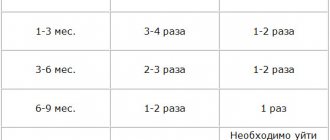Why do breasts sag?
When a woman is expecting a baby, her weight increases. The mammary glands are composed of adipose tissue, so bust size increases along with body weight. Hormonal changes cause the milk ducts to dilate. The chest becomes heavier, which further stretches the ligaments.
After feeding is completed, the milk ducts decrease, but the stretched ligaments, muscles and skin do not have time to return to normal. As a result, the breasts sag after breastfeeding. A similar process occurs if a woman quickly loses weight after finishing breastfeeding.
The degree of sagging depends on several factors:
- Age – over time, a woman’s production of collagen, which is responsible for skin elasticity, decreases.
- Body mass index – being overweight increases your risk of sagging.
- Size – the larger the bust was before pregnancy, the higher the likelihood that it will change shape after breastfeeding.
- Duration, number of feedings - prolapse is directly related to how long and often the woman fed. If the break between breastfeeding sessions was short, then the tissues do not have time to recover and stretch even more.
- Genetics - elasticity and bust size, the amount of fat and glandular tissue are determined by heredity.
Is it possible to restore breasts after childbirth?
Many women believe that breastfeeding is the main reason that breasts lose shape. This is not entirely true; there are factors that can change its appearance even more1:
- Excess weight. Overweight mothers are more likely to experience similar problems.
- Previous pregnancies. The more children you have, the higher the chances that your breasts will lose shape.
- Big size. During pregnancy, it will become even larger, and the load on the ligaments and skin will increase.
- Age. Don't forget that during pregnancy and lactation your breasts will become approximately two years older, and take into account age-related changes.
- Heredity. If your mother had this problem, it may happen to you too.
Rate yourself on this list - this will give you a rough idea of how much your breasts may be affected. If you have few risk factors, recovery will likely not be a problem. If there is, just hope for the best and do your best.
How to maintain breast shape while breastfeeding
To maintain the elasticity of the mammary glands, you need to strengthen the ligaments and muscles, and moisturize the skin. To prevent sagging during breastfeeding, it is recommended to wear a special bra and position yourself correctly when feeding. A contrast shower and moisturizers will help tone the skin.
Nice bra
To maintain breast shape during breastfeeding, special underwear is required. Enlarged breasts require additional support to reduce sprains. After the baby is born, you can buy a nursing bra or a sports model with good fit.
The bra should have wide straps that will not cut into the skin. You need to choose models made from natural fabrics - cotton, bamboo fiber. Even in your sleep you shouldn’t take off your bra. At night, milk production occurs, that is, the ligaments and tissues stretch even more and need support.
Correct position when breastfeeding
Sometimes mothers bend over to place the nipple in the baby's mouth. This position overstrains the pectoral ligaments and contributes to changes in the shape of the bust. You can use a pillow to lift your baby higher and avoid tilting. It is important to monitor your posture - do not slouch, find stable support.
Cold and hot shower
Breasts with breastfeeding require additional toning. A contrast shower is suitable for this - alternating changes of cold and hot water. The procedure will improve blood and lymph circulation in the tissues and make the skin elastic. You should finish your shower with cold water.
Preventive measures
What to do to prevent your breasts from sagging if you are planning to conceive or are carrying a child under your heart? Include special gymnastics for pregnant women in your daily plan, including working out the corresponding muscles.
This will avoid stretching and weakening of the pectoral muscles and ligaments. This is especially important for girls with large busts and significant breast enlargement.
Use a bust massage with water jets when taking a shower (if there are no contraindications). And apply natural, pregnancy-approved skin care products to your skin. This will prevent the appearance of stretch marks and sagging skin.
While breastfeeding:
- Choose the right underwear (natural fabric, wide straps, loose, non-pressure bra).
- Feed your baby in a comfortable position, alternating between sitting and lying down. In a sitting position, the baby sucks out milk better. When lying down, the tissues stretch less.
- Feed your baby on demand and try to avoid hand expression. When manually expressing, you risk stretching the skin.
What to do if mastoptosis does develop? Don't lose heart, do exercises, massages and take care of your bust. A radical method that helps restore shape is mastopexy and augmentation mammoplasty with tissue tightening. But before you decide to have surgery, you should exhaust conservative ways to solve the problem.
Proper breast care - before and after birth
In order for breast restoration after lactation to go as planned, you need to start taking care of it already in the first trimester of pregnancy. At this stage, caring for and restoring breasts after lactation involves choosing appropriate supportive underwear and preventing the appearance of stretch marks.
The bra should be comfortable, with wide straps, without underwires, fit properly and not deform the breasts.
Strengthening and restorative activities will help maintain skin elasticity. Invest in a good cream for stretch marks (stretch marks) and carefully use it several times throughout the day.
To recover, you can take a contrast shower and air baths several times a day, and expose your chest for 5-10 minutes. A gentle massage with lavender, almond and avocado oils is also useful: they improve the process of breast restoration after lactation, increase its elasticity and softness.
What to avoid:
- prolonged exposure to open sun;
- smoking;
- wearing the wrong underwear;
- rubbing any product into the area around the nipples.
When restoring breasts after lactation, it is very important to follow these rules.
Lactostasis
Lactostasis is less scary than mastitis, but it is also unpleasant. These are lumps in the chest, in the mammary glands. They appear due to excess milk. If the seals are small and there is no temperature, it is possible to overcome lactostasis by exposure to cold.
Some apply compresses with Vishnevsky ointment, which also removes inflammation well, while others treat the lump with laser or ultrasound. However, everything is much more serious if the area of the lump is swollen, red, and the temperature rises. Then lactostasis can turn into mastitis.
First menstruation
Any woman who decides to stop breastfeeding should understand that menstruation will inevitably come after breastfeeding ends. They start differently for everyone, for some in the first month after stopping breastfeeding, for others after one or two. It also happens that menstruation resumes during lactation. Everything depends solely on the characteristics of the woman’s body - each has its own.
The above explains in detail what to do when you stop breastfeeding and how to maintain your health. Let's hope this information is useful.
What to do when you stop breastfeeding: useful tips
- When breastfeeding, the baby is fed upon his first request. However, having decided to end this way of eating, you can slowly teach your baby to eat according to a schedule, after a certain amount of time. Of course, provided that the weaning child is large enough and is at least a year old. The number of applications should be reduced gradually, and then it will be possible to slowly but surely bring them to zero.
- It is very important for the mother to take care of the completion of breastfeeding in advance - even when the baby is actively feeding on her milk. Making this as easy as shelling pears is necessary - you must periodically go somewhere for a couple of hours: whether to go shopping, to a cafe with girlfriends, or just to walk along the streets. In the absence of the mother, the baby must learn to interact with other people - who cannot provide him with breasts at his request, and therefore, he will little by little get used to the fact that he can, in general, satisfy his needs and solve problems without breasts. This habit will help both the baby herself and her mother later.
- Once you begin weaning, you should try to refuse the baby when he asks for the breast immediately. However, you cannot simply say “no”; you must explain why breastfeeding will not work for the child now, and promise to do this in the near future. For example: “Baby, wait a little: now I’ll finish ironing the clothes, and then I’ll give you the breast.” An important nuance must be taken into account here: many mothers hope that during this time the child will be distracted by something (or try hard to distract him themselves) and there will be no need to breastfeed. Under no circumstances should you do this - the baby will feel deceived. They promised to breastfeed later, which means you need to keep your promise. In addition, there is no need to immediately establish huge gaps between “baby, wait” and a restrained word. Let the baby’s request first be postponed for five minutes, then for ten, and so on.
- The baby must have one specific place for feeding, and only there can he receive his mother's breast.
- You can limit the number of feedings if you agree with your child that he will only breastfeed while at home (not on the street/in a store/at a party).
- If the baby whines in response to refusal, there is no need to give up ground. Light, dissatisfied crying can be tolerated. But if it develops into a prolonged hysteria, then it is necessary to give in to the child (but, of course, it is better not to lead to hysteria).
- Instead of breastfeeding, you can offer your baby something he likes to eat - if he is hungry, or something that can keep him busy and entertained - if he is bored.
- You cannot eliminate night breastfeeding until it is eliminated at night. As for the latter, to remove it, it is necessary to introduce some new bedtime ritual instead of falling asleep on your chest. Each family has its own - a lullaby, reading a book, soothing tea, and so on. However, it is important to remember that this particular feeding (like night feeding) cannot be eliminated very quickly. Perhaps a good help would be to gradually reduce the duration of “hanging” on the chest.
- So that the baby does not ask for the breast in the morning, you need to get up before him and greet his awakening with some of his favorite goodies - so that the baby does not even remember about the breast.
- Having decided to stop breastfeeding, it is important to stand firm and not succumb to the tricks and tricks of the little manipulator.
- When weaning your baby, you should not leave him without you for several days. Many mothers consider this solution to be the most optimal, they say, they will be without their mother’s breast for a couple of days and that’s all. This is fundamentally wrong, and can not only traumatize the baby’s psyche, but also result in mastitis or lactostasis for the mother herself.
- To avoid problems with the child’s psyche, you should not change the environment familiar to the baby. There is no need to take him to visit his grandmother, for example, until weaning is completed.
- Some people resort to such radical measures as smearing their breasts with brilliant green or hot pepper. This is a fairly common mistake that should not be repeated. The child perceives his mother’s breast as the most precious, beloved thing he has. For him, breasts covered in greenery or pepper will be tantamount to the same as if an adult discovered something dear to his heart was spoiled.
Fast or slow
Many women, having begun to complete breastfeeding, strive to carry out this procedure as soon as possible. However, all experts agree on the same opinion: it is impossible to quickly wean a child from the breast - after all, a sharp break in an established intimate relationship with the mother can traumatize the baby. It is recommended, with patience, to complete this process within three to four months: this is the period, according to doctors, that is almost ideal, the most painless for the child and for the mother herself. It is unlikely that any woman will want to get problems associated with the onset of lactostasis. Although, of course, it is impossible to fit everyone into a single framework in any case - for some, the completion of breastfeeding is much calmer, easier and, accordingly, faster than in the above period. However, doctors say that to develop a particular habit (in this case, to stop asking for the mother’s breast), a baby, as well as an adult, always needs at least three or even four weeks.
When finishing breastfeeding, a woman should think about two things: how to make sure that her child endures all this painlessly - firstly, and what to do with her own milk and breasts so that no diseases appear - secondly. We'll talk about the second question later, but for now, baby. How to prepare it?










